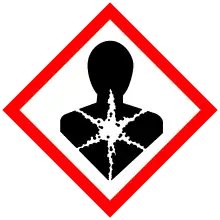Arsenic triselenide
Arsenic triselenide (As2Se3) is an inorganic chemical compound, a selenide of arsenic.
 | |
 | |
| Names | |
|---|---|
| Other names
Arsenic(III) selenide | |
| Identifiers | |
3D model (JSmol) |
|
| ChemSpider | |
| ECHA InfoCard | 100.013.745 |
| EC Number |
|
PubChem CID |
|
| RTECS number |
|
| UNII | |
CompTox Dashboard (EPA) |
|
| |
| |
| Properties | |
| As2Se3 | |
| Molar mass | 386.72 g/mol[1] |
| Appearance | brown-black powder[1] |
| Odor | odorless |
| Density | 4.75 g/cm3[1] |
| Melting point | 377 °C (711 °F; 650 K)[1] |
| insoluble[1] | |
| Structure[2] | |
| Monoclinic, mP20 | |
| P21/c, No. 14 | |
a = 0.43 nm, b = 0.994 nm, c = 1.29058 nm α = 90°, β = 109.927°, γ = 90° | |
Formula units (Z) |
4 |
| Hazards | |
| GHS pictograms |    |
| GHS Signal word | Danger |
| H301, H330, H331, H373, H400, H410 | |
| P260, P261, P264, P270, P271, P273, P284, P301+310, P304+340, P310, P311, P314, P320, P321, P330, P391, P403+233, P405, P501 | |
| NFPA 704 (fire diamond) | |
| Related compounds | |
Other anions |
diarsenic trioxide, diarsenic trisulfide, arsenic tribromide, arsenic(III) telluride |
Other cations |
antimony(III) selenide |
Related compounds |
arsenic(V) selenide |
Except where otherwise noted, data are given for materials in their standard state (at 25 °C [77 °F], 100 kPa). | |
| Infobox references | |
Amorphous arsenic triselenide is used as a chalcogenide glass for infrared optics. When purified, it transmits light with wavelengths between ca. 0.7 and 19 µm.[3]
Arsenic triselenide is covalently bonded. Even so, the arsenic has a formal oxidation state of +3.
Solution processed thin film As2Se3
Thin film selenide glasses have emerged as an important material for integrated photonics due to its high refractive index, mid-IR transparency and high non-linear optical indices. High-quality As2Se3 glass films can be deposited from spin coating method from ethylenediamine solutions.[4]
References
| Wikimedia Commons has media related to Arsenic triselenide. |
- Haynes, William M., ed. (2016). CRC Handbook of Chemistry and Physics (97th ed.). CRC Press. p. 4.49. ISBN 9781498754293.
- Renninger, A. L.; Averbach, B. L. (1973). "Crystalline structures of As2Se3 and As4Se4". Acta Crystallographica Section B. 29 (8): 1583–1589. doi:10.1107/S0567740873005091.
- Guillevic, Erwan; Zhang, Xianghua; Adam, Jean-Luc; Ma, Hongli; Lucas, Jacques; Tariel, Hugues (2011). "Fabrication of highly homogeneous As2Se3 glass under argon flow". Journal of Non-Crystalline Solids. 357 (15): 2897–2902. Bibcode:2011JNCS..357.2897G. doi:10.1016/j.jnoncrysol.2011.03.030.
- Zou, Yi; Lin, Hongtao; Ogbuu, Okechukwu; Li, Lan; Danto, Sylvain; Novak, Spencer; Novak, Jacklyn; Musgraves, J. David; Richardson, Kathleen; Hu, Juejun (2012). "Effect of annealing conditions on the physio-chemical properties of spin-coated As2Se3 chalcogenide glass films". Optical Materials Express. 2 (12): 1723. Bibcode:2012OMExp...2.1723Z. doi:10.1364/OME.2.001723. S2CID 32070511.
This article is issued from Wikipedia. The text is licensed under Creative Commons - Attribution - Sharealike. Additional terms may apply for the media files.
